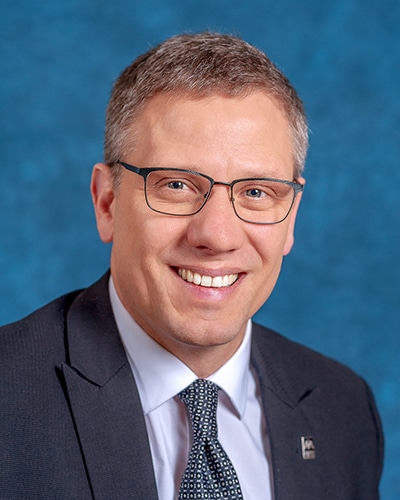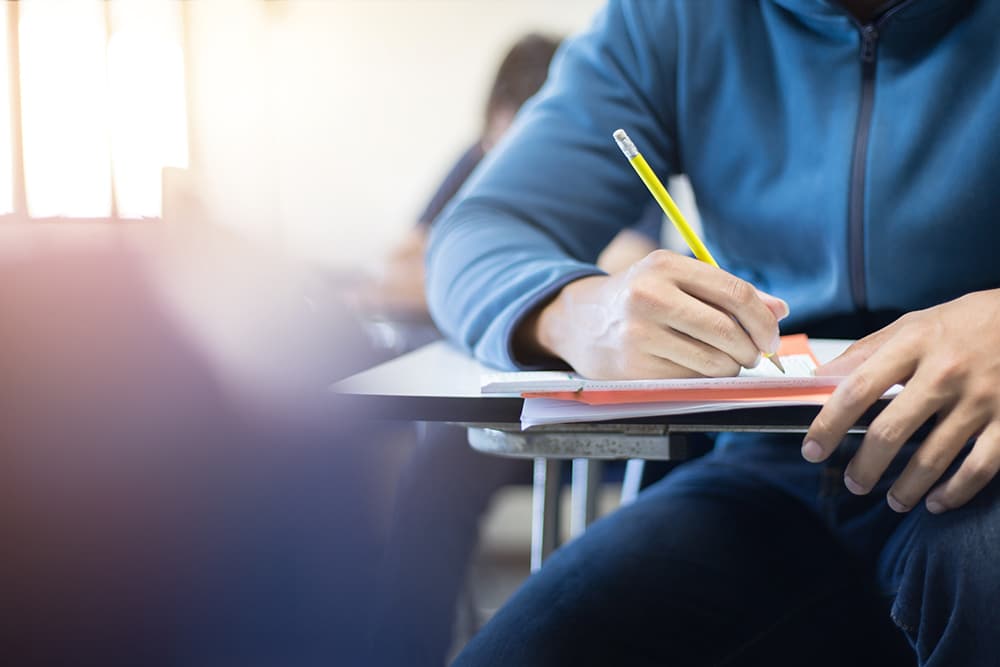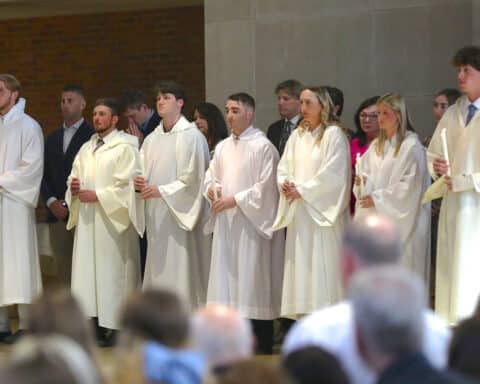It’s back-to-school time for college students across the country, but it is not business as usual as they return to campus. Schools are adopting measures with the goal of making classrooms as normal as possible while also coordinating with state requirements and health department recommendations.
Adaptations include: classes getting moved to larger rooms or split up and staggered, improved room ventilations, directed traffic flow, increased sanitation, and varying policies for wearing masks. Colleges are planning for primarily in-person class attendance while offering simultaneous virtual learning in cases where a student or professor has extenuating circumstances such as being ill or having underlying health issues. The ideal is classroom learning while measures are enacted for optimum safety.
Read other stories in our special college section here.
Travis Feezell, the provost of Belmont Abbey College in North Carolina, told Our Sunday Visitor that classrooms will be different primarily in terms of the physical layout and the attendance of students. “We have spaced the classrooms to allow for social distancing which has reduced capacity by roughly 50% in each room,” he said. “Where the reduction in seating does not allow for the entire class population to attend, we will split the class into cohorts with one cohort attending in person while the other attends via Zoom.” Each classroom will be outfitted with a camera and microphone so that the class itself can be viewed by students in a remote location.
“The issues that are the most challenging for any college right now,” Feezell explained, “are around how we prudently conduct our activities given the very social and interactive nature of an on-campus and in-person classroom experience. When we are socially distanced and wearing masks, when we have half the courses in a Zoom session, when vibrant on-campus activities must be mediated, this presents significant challenges.”
The adaptations, according to him, are centered around how, not whether, students will be back in the classroom. The goal, Feezell stated, is to maintain the essence of the activity while also putting measures in place to maintain the safety of the campus community. In the situation where students must go off campus, such as for business internships, they have put in place a policy agreement with intern providers stating that students should comply with company requirements.
Community learning
At John Paul the Great Catholic University in Escondido, California, Derry Connolly, president and professor of business, explained that local regulations have been a challenge. Students have been prohibited from meeting on campus despite many stores being filled with customers. “Many students do not learn as well online; they struggle when not in community,” Connolly said. “We will continue no matter what. I’m glad we start so late, so hopefully the problem will be solved by then for the good of the students.” The school runs year-round on the quarter system. Classes are scheduled to begin on Sept. 28 with orientation the previous day.
Rather than on-campus housing, 50 apartment units are leased for their 240 students, so moderating housing and cafeterias is not an issue for them. The college is prepared for either distance or classroom learning. Since their classrooms will not be able to hold more than 16 students in a classroom, larger classes will continue online.
Another area of learning that has impacted them has been internships for business and communication majors. Some of those moved online for remote work, but Connolly said they are hoping some of those will reopen so that students will benefit from hands-on experiences.
Clinicals rotations
One area that has been especially challenging are majors in the health field that require clinical rotations such as nursing.
Benedictine College in Atchison, Kansas, has 62 students in their nursing program. Jackie Harris, assistant professor of nursing, explained that the usual clinical positions at the larger hospitals were shut down last spring.
Students agree to comply with the hospital protocol, but with increased restrictions and patient load, some facilities halted rotations, at least temporarily. Some of the smaller hospitals picked them up, but it was still not enough for all of the juniors.
“Incoming seniors will be back early in August to make up any clinicals they missed,” Harris said. Juniors will get hands-on experience earlier than usual this year to insure they get that experience in. “We are reaching out to organizations and smaller hospitals that don’t always have as much red tape as the bigger ones do in order to get students in,” Harris said. There will also be an increased use of case studies and simulated patient learning.
Seeking near-normal
Magdalen College, a small liberal arts college in rural Warner, New Hampshire, usually enrolls around 85 students. Eric Buck, interim president, noted that last spring’s distance learning disrupted their style of education. “Our students engage in Socratic dialogue, so having discussions and pursuing wisdom in the classroom is at the heart of what Magdalen is about,” he explained. They will return to that, full-swing this semester.
In-person classes will begin Sept. 1 with no fall breaks. Visitors will not be prevented from coming to campus, but it is discouraged. Their last week of class and the week of finals will be held remotely right after Thanksgiving. Given that students come from around the country, Buck said they are asked to come 3-5 days before classes start to be tested.
“We plan to have our normal full week of orientation with class introductions, outdoor meals together, orientation for faculty and staff, and the Mass of the Holy Spirit,” he said. “All the things we’ve done to create a community, we will still do — even if we have to accommodate the guidelines of the diocese — not to lose the customs and traditions that Magdalen is about.”

At the University of Mary in Bismarck, North Dakota, executive vice president Jerry Richter stated, “We are fully committed to have as much of a normal school year as possible.” Founders hall which is usually reserved for speakers, will be utilized as a classroom to allow for ample space. Classes will be staggered where necessary, and student numbers and room size will provide enough distance. Wherever adequate social distance can be maintained, students will not be required to wear masks. Exceptions are clinicals and labs and any situations that require close contact.
University of Mary has established a 5-level monitoring system to post on their website. “Students can check it each day before they go to class,” Richter said. “We just need to turn the dial depending on the current situation.” For instance, Level 1 would be a new normal with heightened hygiene and sanitation. At Level 2, there will be more spacing and online learning upon request. Level 3 limits gatherings to 75%. Level 4 prohibits commuter students from coming on campus, and at Level 5, education moves online again.
“We have a clinic on campus and space for those that test positive or need to quarantine where they can continue classes online,” Richter explained. The goal, according to him, is for education not to be interrupted and for it to take place in an atmosphere most conducive to learning. “We will do our best to help students stay safe and healthy, but life needs to go on,” he said.
Patti Maguire Armstrong writes from North Dakota.





